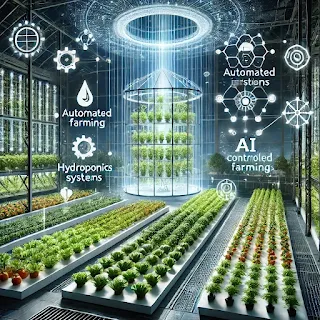Introduction
As climate change intensifies, traditional farming methods are struggling to keep pace with rising temperatures, erratic weather patterns, and depleting natural resources. Climate-smart agriculture (CSA) integrates technology and sustainable practices to address these challenges, ensuring a stable and resilient food supply. By leveraging smart greenhouses, precision farming, and AI-driven solutions, CSA enhances food security while reducing agriculture’s environmental footprint.
This article explores how climate-smart agriculture benefits lifestyles, health, the environment, and food security at national and global levels.
The Rise of Climate-Smart Agriculture Technology
Climate-smart agriculture incorporates technological innovations to improve efficiency, sustainability, and resilience. Some of the key advancements include:
1. Smart Greenhouses and Controlled Environment Agriculture (CEA)
Greenhouses equipped with AI and IoT sensors optimize light, humidity, and temperature for crop growth.
Example: KAUST’s cooling system uses seawater-cooled greenhouses to grow fresh produce in arid regions.
Vertical farming and hydroponic systems minimize water use and land requirements.
2. Precision Farming with AI and IoT
Drones and satellite imagery provide real-time data on soil conditions and crop health.
AI-driven analytics guide farmers on optimal planting and harvesting times.
Automated irrigation systems reduce water waste, ensuring sustainable resource use.
3. Pesticide-Free and Organic Farming Technologies
AI-powered pest detection helps reduce pesticide dependency, promoting healthier food options.
Biological pest control uses natural predators instead of chemical sprays.
Genetically improved crops resist pests and diseases naturally, reducing chemical intervention.
4. Carbon-Neutral and Regenerative Agriculture
Carbon-sequestering soil techniques reduce farming’s environmental impact.
Smart crop rotation and cover crops improve soil fertility while cutting emissions.
Agroforestry integrates trees and crops, enhancing biodiversity and carbon capture.
Lifestyle Benefits: Local, Fresh Food through Smart Greenhouses
Consumers are demanding fresher, locally grown food that reduces supply chain emissions. Smart greenhouses and urban farming meet this need by:
Enabling year-round cultivation of fresh fruits and vegetables.
Reducing transportation costs and carbon footprints.
Providing nutrient-rich produce free from excessive chemical treatments.
Health Benefits: Safer Diets with Reduced Pesticides
Excessive pesticide use in conventional farming has been linked to various health issues, including hormonal imbalances and neurological disorders. Climate-smart agriculture offers healthier alternatives by:
Utilizing biological pest management strategies instead of synthetic chemicals.
Reducing pesticide residues in food, lowering the risk of toxic exposure.
Encouraging soil health improvements that enhance nutrient content in crops.
Environmental Impact: Lowering Farming’s Ecological Footprint
Agriculture is a leading contributor to deforestation, water shortages, and greenhouse gas emissions. CSA minimizes its environmental impact through:
Water-efficient irrigation: Drip irrigation and hydroponics use up to 90% less water than conventional farming.
Reduced soil degradation: No-till farming and crop diversification improve soil health.
Lower methane emissions: Advanced waste management and precision livestock farming cut methane output from dairy and meat production.
National-Level Impact: Strengthening Food Security in Arid Regions
Countries facing water scarcity and extreme heat, such as those in the Middle East and Africa, benefit greatly from climate-smart agricultural solutions.
1. Enhancing Self-Sufficiency
Reducing reliance on food imports by increasing local food production.
Developing resilient crop varieties that can thrive in arid climates.
Implementing desalination-powered irrigation to overcome water shortages.
2. Economic Growth and Employment
Smart agriculture creates jobs in AgriTech, AI-driven farming, and greenhouse management.
Expanding local farming industries boosts national economies and trade resilience.
Global Impact: Fighting Hunger Amid Climate Change
As per World Economic Forum (WEF) reports, climate change threatens global food production. Climate-smart agriculture helps combat this crisis by:
1. Addressing Global Food Insecurity
Ensuring food availability despite climate disruptions.
Developing global seed banks to preserve climate-resilient crops.
2. Promoting Sustainable Agriculture Worldwide
Encouraging global investment in AgriTech startups.
Strengthening international policies on food sustainability and environmental responsibility.
Challenges and the Future of Climate-Smart Agriculture
Despite its potential, climate-smart agriculture faces challenges such as:
High initial investment costs for smart farming infrastructure.
Limited access to technology in developing nations.
Need for policy reforms to support sustainable farming practices.
With ongoing innovations, decreasing costs, and growing governmental support, climate-smart agriculture will play a pivotal role in shaping the future of global food production.
Conclusion
Climate-smart agriculture is transforming food security, human health, and environmental sustainability. By embracing smart greenhouses, precision farming, and eco-friendly agricultural practices, we can mitigate the impacts of climate change on global food production.
Investing in AgriTech and sustainable farming policies is crucial to ensuring a future where fresh, healthy, and environmentally responsible food is accessible to all. As nations, industries, and individuals take steps toward climate-smart agriculture, we move closer to a more resilient and food-secure world.

No comments:
Post a Comment